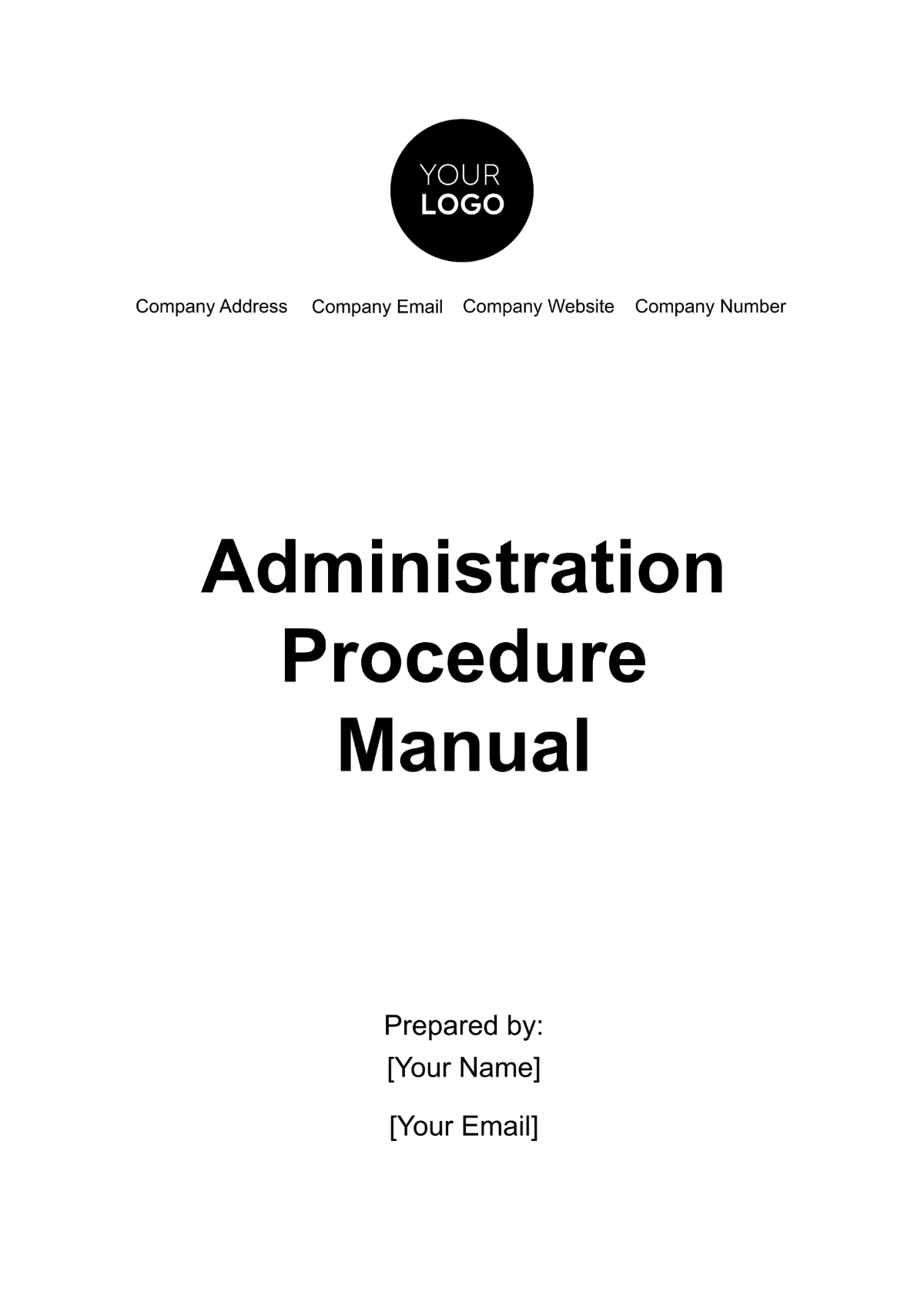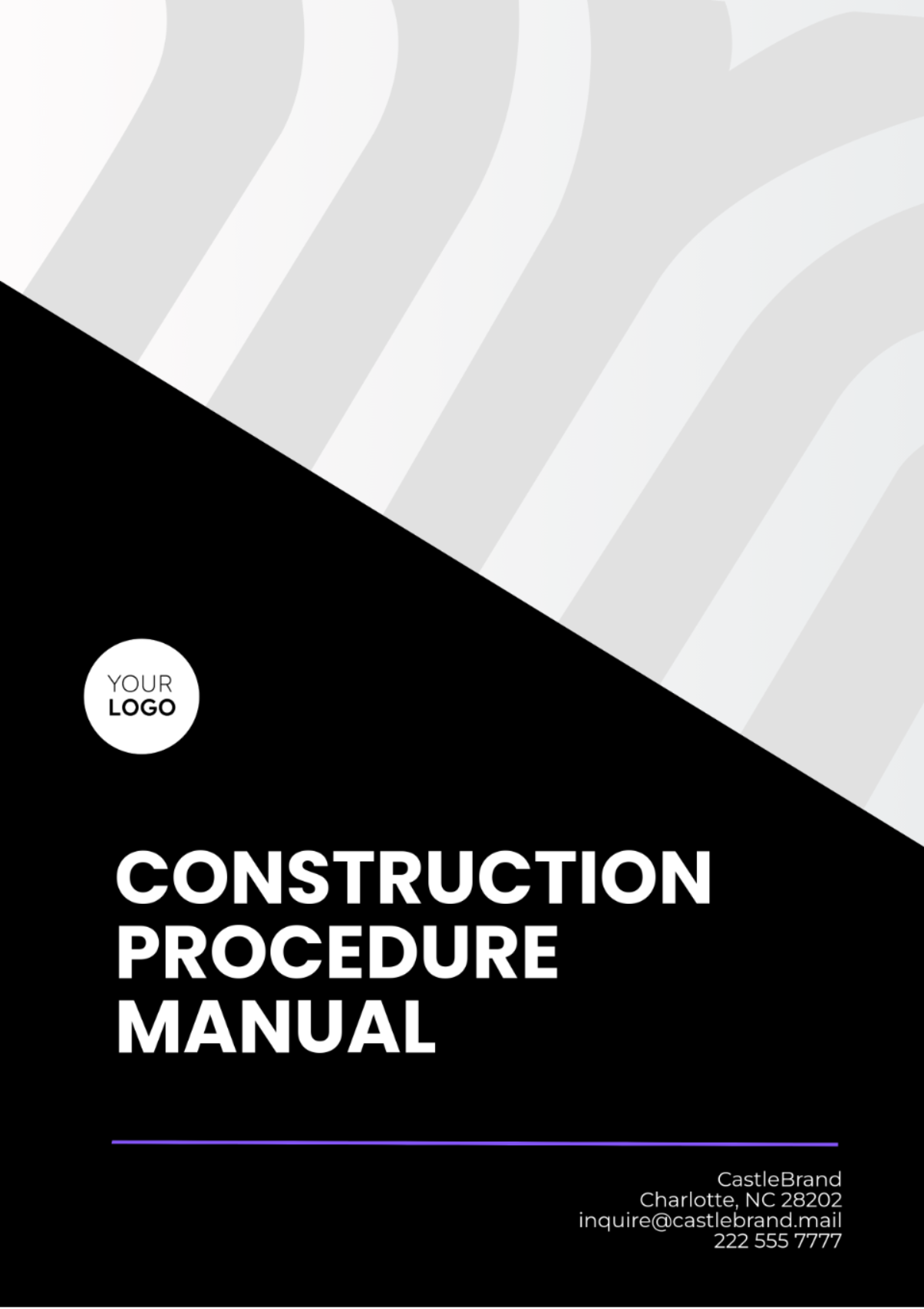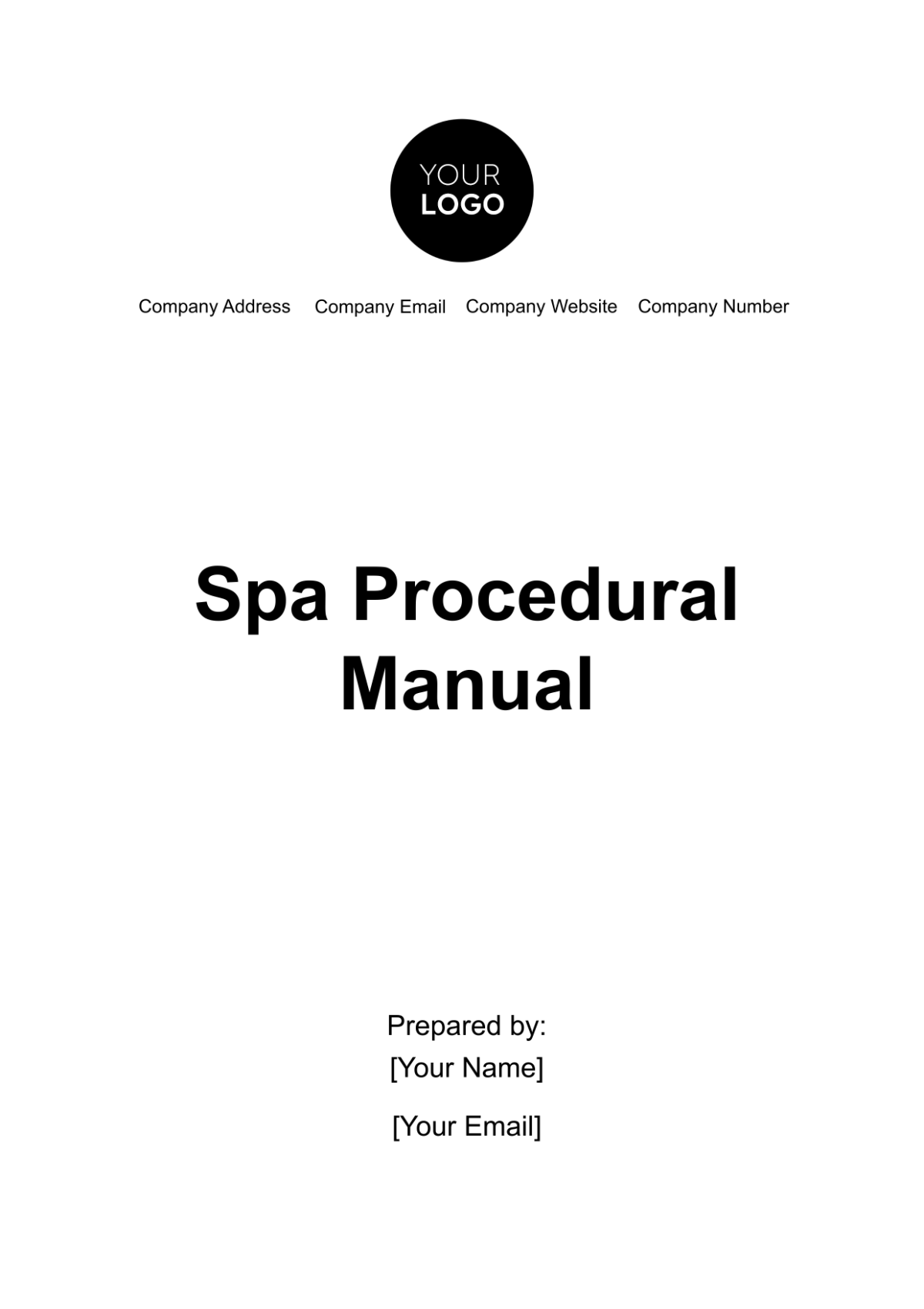Operations Procedure Manual
Name | Company Name | Department | Date |
|---|---|---|---|
[YOUR NAME] | [YOUR COMPANY NAME] | [YOUR DEPARTMENT] | [DATE] |
I. Introduction
The Operations Procedure Manual is a comprehensive guide designed to streamline [YOUR COMPANY NAME] operational processes and ensure consistency in day-to-day activities. This manual serves as a valuable resource for employees within the [YOUR DEPARTMENT], providing clear instructions on performing tasks efficiently and effectively. By following the guidelines outlined in this manual, employees can contribute to the overall success and productivity of the organization.
Purpose
The purpose of this manual is to:
Standardize Procedures: Establish uniform procedures across all departments to maintain consistency and quality in operations.
Ensure Compliance: Ensure that all operations are conducted in accordance with regulatory requirements and company policies.
Enhance Efficiency: Streamline processes to improve efficiency and productivity, ultimately leading to better outcomes.
Facilitate Training: Serve as a training resource for new employees, providing them with clear instructions on how to perform their duties.
II. Getting Started
A. Manual Overview
The Operations Procedure Manual is divided into several sections, each addressing specific aspects of [YOUR COMPANY NAME] operations. Users can easily navigate through the manual using the table of contents provided at the beginning of the document.
B. Document Structure
Section Organization: The manual is organized hierarchically, with sections and subsections clearly labeled for easy reference.
Formatting: Important information, procedures, and guidelines are highlighted in bold or listed in bulleted or numbered format for clarity.
C. Using the Manual
Read Carefully: It is essential for employees to read each section carefully to understand the procedures and guidelines thoroughly.
Refer Frequently: Employees are encouraged to refer back to the manual whenever they encounter uncertainties or need guidance on performing specific tasks.
III. Operational Procedures
A. Inventory Management Procedure
Overview
Inventory Management outlines the steps required to efficiently manage [YOUR COMPANY NAME] inventory. This procedure is essential for ensuring optimal utilization of resources and timely fulfillment of orders.
Procedure
Conduct a thorough inventory assessment to determine current stock levels and identify any discrepancies.
Implement a system for tracking inventory movements, including receiving, storage, and distribution.
Regularly update inventory records to maintain accuracy and prevent stockouts or overstock situations.
Tips
Efficiency: Streamline inventory processes by implementing barcode scanning or automated inventory management systems.
Quality: Regularly inspect inventory for damage or expiration to maintain product quality.
Safety: Store hazardous materials in designated areas and ensure compliance with safety regulations.
B. Customer Service Procedure
Overview
The Customer Service Procedure details the process of handling customer inquiries and resolving issues promptly and effectively. It is crucial for maintaining high levels of customer satisfaction and loyalty.
Procedure
Acknowledge customer inquiries promptly and courteously, either in person, over the phone, or via email.
Listen attentively to customer concerns and gather all necessary information to address their needs.
Provide timely and appropriate solutions to resolve customer issues, keeping them informed throughout the process.
Best Practices
Documentation: Keep detailed records of customer interactions and resolutions for future reference.
Communication: Maintain open and transparent communication with customers, providing regular updates on the status of their inquiries or issues.
Feedback: Encourage customers to provide feedback on their experiences to identify areas for improvement and enhance service quality.
IV. Emergency Procedures
A. Emergency Evacuation
Overview
The Emergency Evacuation procedure provides guidelines for evacuating [YOUR COMPANY NAME] premises safely in the event of an emergency.
Procedure
Alert: Upon hearing the evacuation alarm, immediately stop all tasks and proceed to the nearest exit.
Evacuation Route: Follow the designated evacuation route, avoiding elevators and using stairwells instead.
Assembly Point: Proceed to the designated assembly point outside the building and await further instructions.
Important Reminders
Stay Calm: Remain calm and assist others if necessary.
Do Not Re-enter: Do not re-enter the building until it has been declared safe to do so.
B. Emergency Contact Information
Overview
The Emergency Contact Information section provides employees with essential contact details in case of emergencies.
Contacts
Emergency Services: [PHONE NUMBER]
Company Emergency Contact: [EMERGENCY NUMBER]
Medical Facilities: [LOCATION AND CONTACT OF NEARBY MEDICAL FACILITIES]
V. Quality Assurance Procedures
A. Quality Control Checks
Overview
Quality Control Checks ensure that products or services meet [YOUR COMPANY NAME] standards of quality and excellence.
Procedure
Initial Inspection: Conduct an initial inspection to identify any defects or discrepancies.
Quality Testing: Perform quality testing using [specified methods or tools].
Documentation: Document any issues found and take appropriate corrective actions.
Quality Standards
Accuracy: Ensure that products or services meet specified accuracy requirements.
Consistency: Maintain consistency in product or service quality.
Customer Satisfaction: Prioritize customer satisfaction by delivering high-quality products or services.
B. Continuous Improvement Process
Overview
The Continuous Improvement Process involves identifying areas for improvement and implementing changes to enhance efficiency and effectiveness.
Procedure
Identification: Identify areas for improvement through employee feedback, customer surveys, and performance evaluations.
Analysis: Analyze the root causes of inefficiencies or issues identified.
Implementation: Implement changes or solutions to address identified issues.
Evaluation: Evaluate the effectiveness of implemented changes and make further adjustments as necessary.
Benefits
Increased Efficiency: Streamline processes to reduce waste and improve productivity.
Enhanced Quality: Implement improvements to deliver higher-quality products or services.
Employee Engagement: Encourage employee involvement in the improvement process, leading to higher morale and job satisfaction.
VI. Training and Development Procedures
A. New Employee Onboarding
Overview
The New Employee Onboarding procedure ensures that new hires are smoothly integrated into [YOUR COMPANY NAME] culture and operations.
Procedure
Orientation: Provide new employees with an orientation session to introduce them to the company's mission, values, and culture.
Training: Conduct training sessions to familiarize new hires with their roles, responsibilities, and procedures.
Mentorship: Assign a mentor to new employees to provide guidance and support during the onboarding process.
Feedback: Gather feedback from new hires to identify areas for improvement in the onboarding process.
Importance of Onboarding
Retention: Effective onboarding contributes to higher employee retention rates.
Productivity: Properly onboarded employees are more productive and contribute to the organization's success.
Engagement: Onboarding fosters employee engagement and loyalty to the company.
B. Skills Development Training
Overview
Skills Development Training aims to enhance the skills and competencies of employees to meet the evolving needs of [YOUR COMPANY NAME].
Procedure
Training Needs Assessment: Identify the skills gaps and training needs of employees through performance evaluations and feedback.
Training Plan Development: Develop a comprehensive training plan that addresses the identified skills gaps and aligns with organizational goals.
Implementation: Deliver training sessions using a variety of methods such as workshops, seminars, and online courses.
Evaluation: Evaluate the effectiveness of training programs through assessments, feedback, and performance metrics.
Benefits of Skills Development
Improved Performance: Employees with upgraded skills perform their jobs more effectively, leading to better outcomes.
Employee Engagement: Investing in employee development demonstrates the organization's commitment to their growth and fosters higher engagement.
Competitive Advantage: Continuous skills development enables [YOUR COMPANY NAME] to stay competitive in the market by adapting to changing industry trends.
VII. Health and Safety Procedures
A. Workplace Safety Guidelines
Overview
Workplace Safety Guidelines are designed to ensure the health and safety of all employees and visitors within [YOUR COMPANY NAME] premises.
Procedure
Risk Assessment: Conduct regular risk assessments to identify potential hazards in the workplace.
Safety Training: Provide employees with comprehensive safety training to equip them with the knowledge and skills to mitigate risks.
Safety Equipment: Ensure that appropriate safety equipment is available and properly maintained.
Emergency Procedures: Establish clear procedures for responding to emergencies such as fires, accidents, or medical emergencies.
Importance of Workplace Safety
Employee Well-being: Prioritizing workplace safety demonstrates [YOUR COMPANY NAME] commitment to the well-being of its employees.
Legal Compliance: Compliance with safety regulations helps avoid legal penalties and ensures a safe working environment.
Productivity: A safe workplace fosters employee confidence and productivity, leading to better business outcomes.
B. Ergonomics Guidelines
Overview
Ergonomics Guidelines aim to optimize the design of workspaces and equipment to enhance comfort and prevent musculoskeletal injuries.
Procedure
Workspace Design: Design workspaces to promote proper posture and reduce strain on muscles and joints.
Equipment Setup: Ensure that furniture and equipment are properly adjusted to fit the individual needs of employees.
Regular Breaks: Encourage employees to take regular breaks to stretch and relax their muscles.
Training: Provide training on ergonomic principles and techniques to raise awareness among employees.
Benefits of Ergonomics
Injury Prevention: Proper ergonomics reduces the risk of musculoskeletal disorders and injuries.
Increased Comfort: Ergonomic workspaces enhance employee comfort, leading to higher job satisfaction and morale.
Productivity: Employees are more productive when they are comfortable and free from discomfort or pain.
VIII. Conclusion
The Operations Procedure Manual underscores [YOUR COMPANY NAME] commitment to maintaining a safe and healthy work environment for all employees. By adhering to the health and safety procedures outlined in this manual, employees can perform their duties with confidence and peace of mind.
For any health and safety-related inquiries or concerns, please contact [YOUR NAME] at [YOUR EMAIL].
This manual template provides a comprehensive framework for documenting health and safety procedures within [YOUR COMPANY NAME]. Customize the content to align with your organization's specific safety protocols and ensure that all employees are aware of their responsibilities in maintaining a safe
workplace.

















































